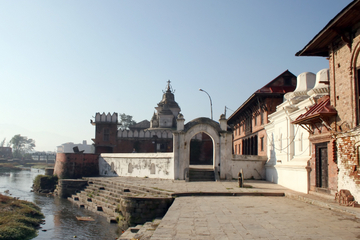
Bagmati River
At first glance, the Bagmati River might appear to be just an ordinary river, meandering its way through the Kathmandu Valley in Nepal. However, the Bagmati holds a great deal of religious significance to Hindus and Buddhists in the country, making it a destination for Nepali and visitors alike.
From the temples lining its banks to the funereal ceremonies that take place in its waters, the Bagmati has been mentioned as a holy place for more than 2000 years and is considered the source of Nepalese civilization; Kathamandu has grown up along its banks. The river is lined with
ghats, stone-paved embankments and stairs that lead down to the waters. These areas, often dotted with statues, are used for the open-air cremations that take place on the Bagmati as well as ritual bathing, though the bathing is becoming a less common practice due to the pollution and receding of the river.
Several temples can be found near the river, including the Gokarneswor Temple at Gokarna and the Hindu Temple of Pashupatinath, dedicated to Shiva, which is located north of Kathmandu on an area above the Bagmati. Non-Hindus are not allowed inside the temple, but they can go to view the river and the cremation rituals that are followed on the banks of the river.
Perhaps what draws most visitors to this area is the chance to see one of the many cremations that take place. Rather than a private affair, like most Western cremations, Hindu creations are public ceremonies. With the oldest son acting as chief mourner, the deceased is dipped into the Bagmati three times for purification before the pyre is lit; members of the family often enter the river or sprinkle themselves with water for spiritual purification.
Today, the Bagmati is suffering from pollution due to the large numbers of inhabitants in Kathmandu. As the garbage and raw sewage build up, there are efforts being made to clean up the holy river, but it’s a slow process. As there is little to no oversight from government to prevent companies from dumping in the river, the waste from large entities and individuals continues to multiply. There are efforts being made to clean up the Bagmati, but it’s going to take collaboration and cooperation to restore this heritage site.
